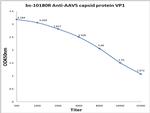Search Thermo Fisher Scientific
Bioss
Adeno-Associated Virus Capsid Protein VP1 Polyclonal Antibody
FIGURE: 1 / 1
Adeno-Associated Virus Capsid Protein VP1 Antibody (BS-10180R) in ELISA

Product Details
BS-10180R
Species Reactivity
Host/Isotype
Class
Type
Immunogen
Conjugate
Form
Concentration
Purification
Storage buffer
Contains
Storage conditions
Shipping conditions
Target Information
Capsid protein self-assembles to form an icosahedral capsid with a T=1 symmetry, about 22 nm in diameter, and consisting of 60 copies of three size variants of the capsid protein VP1, VP2 and VP3 which differ in their N-terminus. The capsid encapsulates the genomic ssDNA. Binds to host cell heparan sulfate and uses host ITGA5-ITGB1 as coreceptor on the cell surface to provide virion attachment to target cell. This attachment induces virion internalization predominantly through clathrin-dependent endocytosis. Binding to the host receptor also induces capsid rearrangements leading to surface exposure of VP1 N-terminus, specifically its phospholipase A2-like region and putative nuclear localization signal(s). VP1 N-terminus might serve as a lipolytic enzyme to breach the endosomal membrane during entry into host cell and might contribute to virus transport to the nucleus.
For Research Use Only. Not for use in diagnostic procedures. Not for resale without express authorization.
References (0)
Bioinformatics
Protein Aliases: VP1

Performance Guarantee
If an Invitrogen™ antibody doesn't perform as described on our website or datasheet,we'll replace the product at no cost to you, or provide you with a credit for a future purchase.*
Learn more
We're here to help
Get expert recommendations for common problems or connect directly with an on staff expert for technical assistance related to applications, equipment and general product use.
Contact tech support
